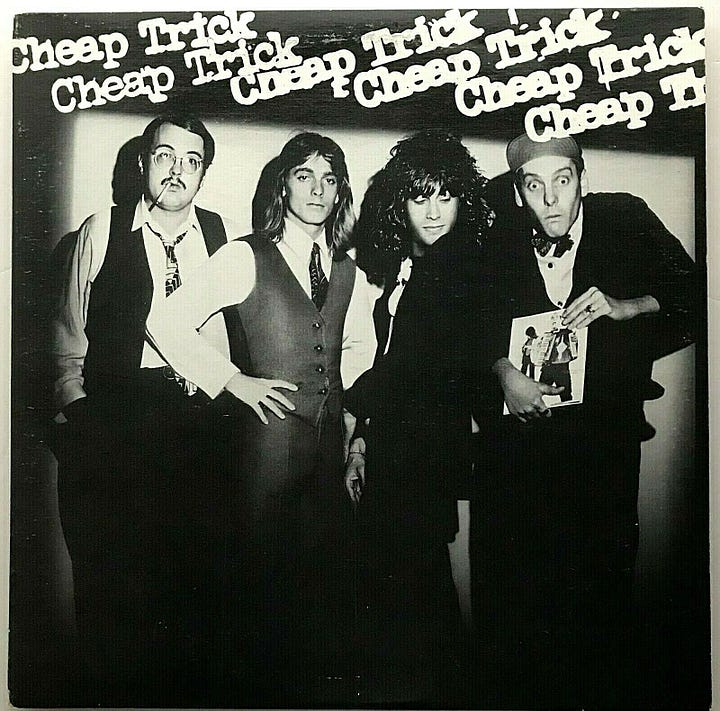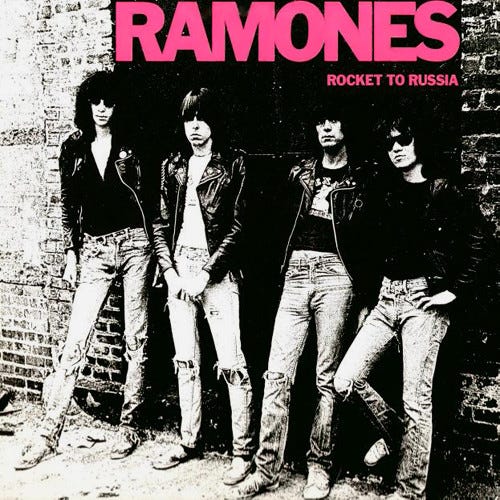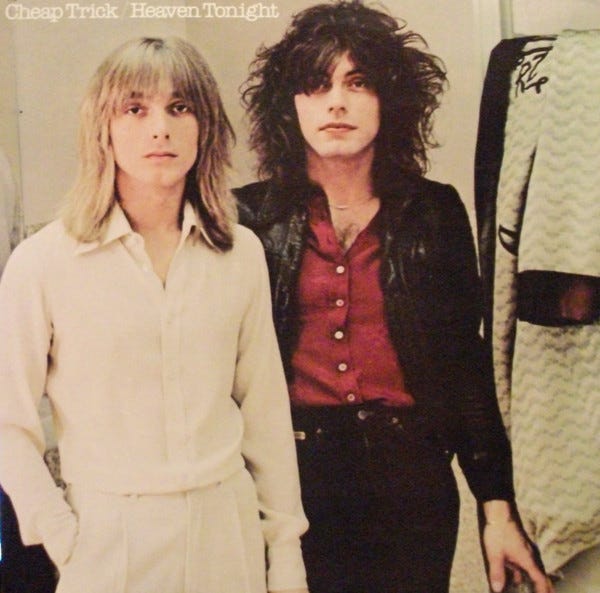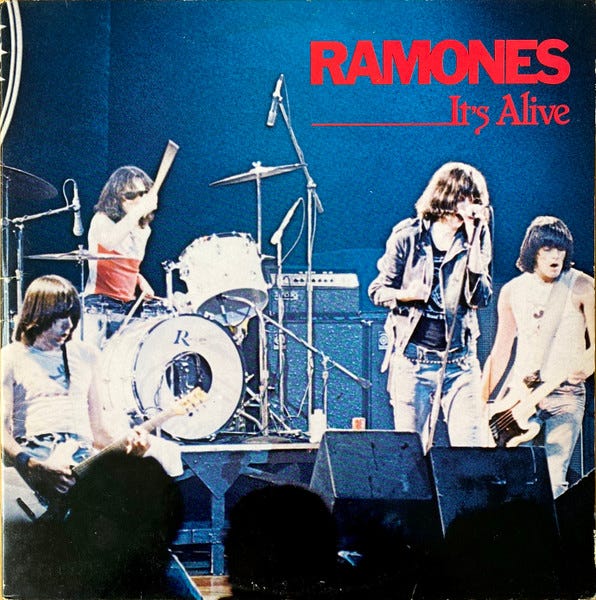Rocket to Heaven Tonight
Flashing back to how the first five Ramones and Cheap Trick studio LPs followed the same creative trajectory
We passed a couple of major rock n’ roll anniversaries this week — April 23 was the 47th anniversary of the Ramones’ groundbreaking self-titled debut album, and Cheap Trick’s glorious Heaven Tonight was released 45 years ago on April 24.
Which got me thinking about couple of things. For one, how lucky I was to have been able to hear, absorb and experience two of America’s greatest and most influential rock bands of the 1970s in their respective primes, even if I didn’t actually get hip to either of them until 1979, several years after they were already up and rocking. But beyond that, it’s fascinating to me how the first five albums from two very different bands followed essentially the same creative trajectory — or the first six albums overall, if you count their recorded-in-a-foreign-land live records.
To some extent, these parallel paths resulted from the music industry norms of the era. Major labels of the 1970s (Cheap Trick were on Epic from the get-go, while the Ramones’ Sire home was picked up for distribution by Warner Brothers in 1977, then folded into WB a year later) often gave their new acts several chances to “find themselves” and find an audience before pushing for the hit record that would bring return on their investment. At the same time, it was pretty standard for major label artists to release new albums at a once-a-year clip, if not more frequently than that.
Still, both the Ramones and Cheap Trick arrived fully formed — both musically and conceptually — with their respective debut albums, so their development over the next four studio efforts was more a question of refinement than reinvention. Cheap Trick got lucky and struck a commercial vein, while the Ramones struggled to break free of the baggage that came with being called a “punk band” in those days. But they both progressed on album at an almost weirdly similar rate. Let’s take a look…
The Raw Debut


The first Ramones album was released in April 1976, and Cheap Trick’s debut came out the following February. Both featured black and white cover images that almost dared you to buy the record — like, “Are you sure you want to hang with these guys?” Both albums opened with stomping tracks with trace elements of the glam-rock era (“Blitzkrieg Bop” and “ELO Kiddies”); both contained covers of songs that seemed completely out of left field at the time (Chris Montez’s “Let’s Dance,” Terry Reid’s “Speak Now or Forever Hold Your Peace”); both included songs about male prostitution (“53rd & 3rd,” “He’s a Whore”); and both touched on the sort of topics that rock songs back then rarely dealt with (child abuse in “Beat on the Brat,” suicide in “Oh, Candy”). Neither band would ever sound as raw as this again, or as weird.
The Slick(er) Sophomore LP


Leave Home, the second Ramones album, was released in January 1977, a month before Cheap Trick’s debut. In Color, Cheap Trick’s sophomore effort, was released that September. Both featured blue-ish cover images implying that the bands were on the move, though only the hot guys in Cheap Trick appeared on the front of their record; with the Ramones, the gang image took precedence over highlighting any hot guys in the band. (Some might argue that they didn’t have any to highlight.) The songwriting on both albums was tighter, more focused and slightly more evolved than on the debuts, and the production values were considerably more “pro”. But while the improved production definitely worked in the Ramones’ favor (many listeners, myself included, think it’s their best-sounding album), the prevailing opinion of In Color is that producer Tom Werman softened Cheap Trick’s edges a tad too much. I love it regardless, but can totally understand that perspective.
The Stone-Cold Classic


If I had to pick just one Ramones LP and one Cheap Trick LP to listen to for the rest of my life, 1977’s Rocket to Russia and 1978’s Heaven Tonight would be my choices, and I daresay plenty of other folks would be right there with me. Loaded with classic tracks, produced to emphasize the musicians’ unique strengths —Tom Werman got his shit together this time — and containing few if any weak spots (okay, so Cheap Trick’s DJ-fellating “On the Radio” is a little cheesy, but it’s still a lot of fun), these classic albums showcase each band’s original lineups at the absolute peak of their powers.
The Live Interlude


Live albums were a big deal in the 1970s, and it wasn’t unusual for a band to break through to a higher level of success on the strength of a live album that featured faster and/or more elongated renditions of previously released tunes. (As a teen, I would usually buy a band’s live album first, because it was like having a more aggressive and exciting “greatest hits” LP.) But while it is now widely considered the greatest live album of the punk era, the Ramones’ manic It’s Alive — recorded December 31, 1977 at London’s Rainbow Theatre — wasn’t released in the US, and sat in the Sire vaults for over a year before it slithered out into the rest of the world. Cheap Trick at Budokan was recorded in Tokyo in April 1978 and initially intended as a Japan-only release before Epic decided to put it out in the US in February 1979. Which was a good move, as it catapulted the band into the Top 20 for the first time, and sold over 3 million copies in the States alone. Not that It’s Alive would have necessarily had the same impact on the Ramones’ career, but Sire’s decision to sit on it remains a deeply puzzling and frustrating footnote.
The Slight Comedown with Brilliant Highlights


After brilliant third outings, both bands came up a little short on Album Number Four. Not that 1978’s Road to Ruin or 1979’s Dream Police are without their iconic moments; “I Just Want to Have Something to Do” and “I Wanna Be Sedated” are among the greatest songs the Ramones ever recorded, just as “Dream Police” and “Voices” easily rank among my Cheap Trick Top 10. But overall, both albums suffer from uninspired writing — the Ramones return too many times to the mental illness well with “Go Mental” and “Bad Brain,” while Cheap Trick pad things out with unecessarily long jams on “Gonna Raise Hell” and “Need Your Love”.
The Legendary Producer Album


The two most legendary record producers alive in the late 1970s were Phil Spector and George Martin — the Ramones went off with Spector for their fifth album, while Cheap Trick hired Martin, resulting in two quirkier-than-usual 1980 outings marked by patchy track listings and over-the-top arrangements. Both albums have a handful of undeniably great tracks, including the killer openers “Do You Remember Rock ‘n’ Roll Radio?” and “Stop This Game”. And both albums certainly have their adherents — I know people who consider them their favorite records by these bands. But for me, neither one quite lives up to their “great band meets great producer” potential.
From here, the paths of these two legendary bands diverge wildly; the Ramones would go on to release two genuinely great mid-eighties albums (1983’s Subterranean Jungle and 1984’s Too Tough to Die) to critical raves and continued commercial indifference, while Cheap Trick would regain their commercial footing at the end of the decade with a handful of overproduced records that couldn’t hold a candle to their earlier work. The Ramones packed it in with a farewell tour in 1996, while Cheap Trick regularly tour (with some lineup alterations) to this day. But for a few years there, both bands trod similar paths while delivering exciting, inventive rock music that still holds up remarkably well to this day.
Oh yeah, one more little parallel Ramones/Cheap Trick factoid for ya: While it’s hard to imagine Rock ‘n’ Roll High School without the Ramones, Roger Corman supposedly wanted another band to star in the film… a band called Cheap Trick.




While I have to agree with you that my favorite album by the Ramones is Rocket to Russia, I have to respectfully disagree on your pick for Cheap Trick. My favorite album by the quartet from Illinois is In Color. My favoritism is not due to the slower version of the eventual live hit, “I Want You to Want Me,” but comes more from the strength of the other cuts on the album. “Hello There” is a perfect starter with “Big Eyes,” “Southern Girls,” “Clock Strikes Ten,” “Oh Caroline,” “You’re All Talk” and the glimmering perfect power pop of “Downed,” all tracking after to coalesce into a fantastic album. When I DJ this record nearly always comes with me. There are albums that catch the listener in a perfect way and this is without hesitation that record by Cheap Trick for me.
I totally agree!